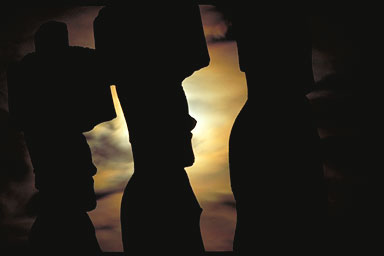|
Loko'Ia
Kia Loko, Guardians of the Pond
By Sam Low
Hana
Hou Magazine
Kahili Award, 2001, Hawaii Visitors
Bureau award for best article celebrating Hawaiian culture.
Hawaii Publishers Association Pa'i award, 2001, Editorial
Feature, first place.
The shoreline is rocky and interspersed with pockets of clear sand beach
and stands of coconut palm bending in the northeast trade winds. There
is the constant sound of surf along the reef and a view of Maui and Lanai
against the southern horizon. But the most prominent view is of a large
stone wall pushing into the lapping waves and enfolding a circle of water
against the shore. This is Kahinapohaku fishpond on Molokai.
The western wall of the pond has been restored to a distance of about
200 yards five feet high and five feet wide with large fitted stones on
two sides and smaller stones between as fill. To the east, the restored
wall extends from thirty yards or so inland along the beach and out into
the sea for perhaps another 100 yards where it becomes a slender line
of disordered stone circling around to join the western wall. Only a year
ago all that was visible here was a slim pile of rocks. The restored part
is a testament to the work of a team of men and women who have braved
a daunting bureaucratic gauntlet to begin a three year project that will
return the fishpond to its former grandeur and productivity.
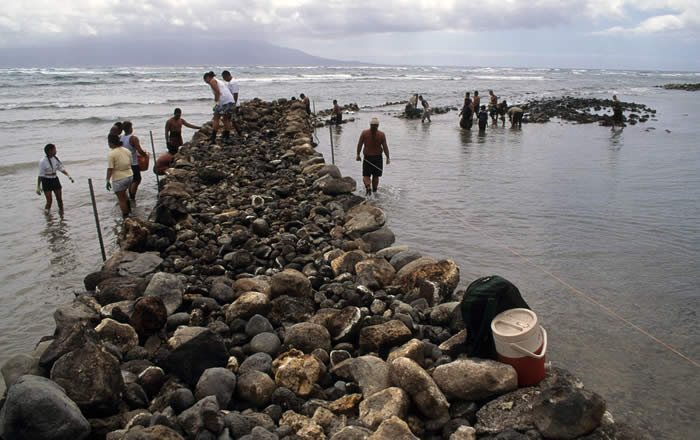
Rebuilding Ancient fish pond
The team is called Loko I'a Kia Loko - guardians of the fishpond - and
Scott Kauhanehonokawailani Adams is their supervisor. He is a handsome
Hawaiian with broad shoulders and a bright smile. In his eyes are bursts
of good humor leavened with pain. Scott freely admits his checkered past
- brushes with the law, six years of heavy drug use - the result of a
deep depression and sadness that he felt whenever he considered the fate
of his people.
"I go to Waimanalo and I see my brothers and sisters living in 1500 square
feet," Scott says, "cannot raise nothing. Penned up in tiny lots. How
they going to live like Hawaiians? I watch TV and I see Hawaiians being
kicked out from Sand Island. I think, 'what happened to our people?' In
school they teach me about Napoleon Bonaparte and I wonder why am I learning
about this man - what does he mean to me? Where is the history of my own
people? And when they teach us about Kamehameha all I learn is he is one
war-like fierce man. I feel like I am a round peg trying to fit into a
square hole. To be successful I've got to have a garage, a car, a dog,
a cat and 2.2 children. I could not see how I was going to achieve that
so I no like being Hawaiian."
Then came the anger. In the rising tide of Hawaiian awareness, of activism
on Kaho'olawe and the ensuing renaissance of Hawaiian pride, Scott returned
to his homestead on Molokai. He erected a tent and hauled water in 55-gallon
drums. He farmed. He spent time alone, thinking about his life.
"The anger was part of the learning process," he says now. "I learned
about the overthrow and the wrongs done to our people. Those were the
militant years. I thought I might take action like at Wounded Knee. I
cried in my tent. I thought, 'for what purpose am I smoking crack? Why
am I making trouble?' And then I remembered something that my father said
to me - 'if you are not part of the solution, you are part of the problem.'
Those angry years were a process of learning. They were enlightening years.
I learned that I was Hawaiian and that I had to find a solution to our
problems as a people."
There were many mentors during this period of enlightenment in Scott 's
life. There were men like George Helm, Emmett Aluli and Eddie Aikau. And
there was Walter Ritte.
"I truly love Walter," Scott says, "because he went through the ringer
for Hawaiians. He always thinks of his people first."
And there were his own kupuna who taught him, as Scott puts it, "to preserve
what generations of my ancestors made and to add my two cents to it" -
advice that he would soon find a way to incorporate into his life. There
was also Hokule'a: "when Hokule'a set sail," Scott explains, "I realized
that my people were extremely smart. The Europeans sailed from one big
continent to another. Columbus could not miss finding land; it was right
there in front of him to crash into. But the Hawaiians sailed from one
tiny speck in the Pacific to another. And they did it long before Columbus.
That was something to be really proud of."
"Then Hokule'a started voyaging all over Polynesia," Scott continues,
"and canoes started popping up everywhere. Makali'i and Hawai'iloa in
Hawaii, others in Aotrearoa and the Cook Islands. I got glimpses of Hokule'a
on TV and what impressed me was how simple the canoe was. I used to think
that only high tech things were beautiful, like a Lamborgini, for example.
But now I saw flashes of a different kind of beauty in Hokule'a and I
saw pride in our people whenever the canoe came in. It was a renaissance.
It was snowballing."
Looking around for something to do, Scott remembered the words of his
kupunas - to preserve and add his 'two cents' to what his ancestors had
left behind. The answer was all over the Molokai landscape - fishponds,
seventy-three of them, all crumbling into the ocean from disuse.
"I saw the fishponds were scattered just like we as a people were," Scott
says. "They and we were not together as one, there was no unity. I saw
that if I did one simple thing - put the rocks back together again - it
would be symbolic of all the Hawaiians coming back together again."
It was a long process. Scott found that you could not just go out and
rebuild an ancient fishpond. There were literally dozens of permits to
obtain - local, state and federal. And the physical work itself was daunting.
A tidal wave had swept ashore in the late 1800's taking out part of the
wall when it came ashore and another part when it receded. All was in
ruins. Akamai now to getting things done in western ways, Scott and others
pursued funding from an alphabet soup of organizations - the EPA, OCS,
CETA, DCSC and EC among them - convincing many that fishponds could provide
a model of how ancient resource management techniques could apply today.
"I think of the fish ponds being like the canary that miners took deep
into the shafts with them," Scott explains. "If the canary died it indicated
that there was poison gas in the mines and the men got out of there fast.
Same thing with the fishponds. If they are unhealthy it means that whole
ahupua'a is unhealthy all the way to the mountaintop, and if the land
is unhealthy then the people cannot be healthy. So if we begin to make
the fish pond healthy once again we help make the land and our people
healthy too."
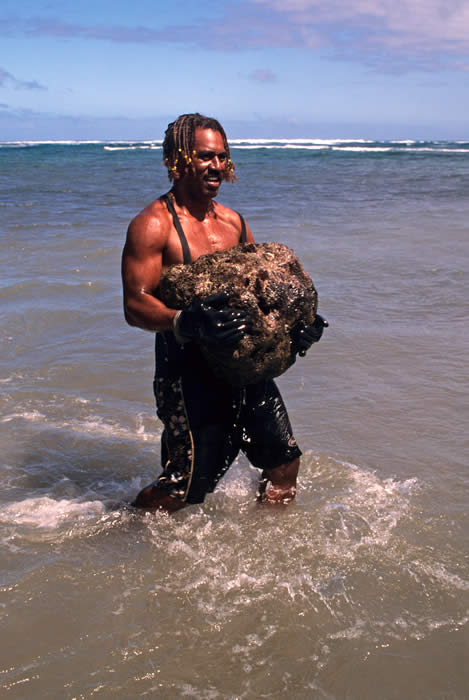
Volunteer carries rock to rebuild wall of fish pond
I found one sure sign of health at Kahinapohaku fishpond on Friday, March
3rd, when I visited to interview Scott about his work. More than thirty
young men and women were there with their teachers from Waipahu high school,
rebuilding the walls of the pond. I had met them earlier, courtesy of
their Molokai guide, Kekama Helm - a crewmember aboard Hokule'a on the
first leg of the voyage to Rapa Nui - from Hawaii to the Marquesas. When
Kekama is not voyaging, he works for the Queen Lilioukalani Children's
Center on Molokai - the kid's local host organization. On the beach, a
dozen or so young women filled bright blue plastic buckets with small
stones while in the gentle waves offshore young men filled their buckets
with larger stones and wrestled up boulders to carry to the wall as fill.
They often sang Hawaiian songs as they worked. Laughter and shouts of
triumph punctuated the sound of offshore surf as each bucket was emptied
into the space between the tall retaining walls. Scott beamed at the men
and women bending over this arduous task.
"When we get akamai kids like these here to work on the pond," he says,
"I think I can see the light at the end of the tunnel. When I was their
age in my heart I was not Hawaiian. I looked like a Hawaiian. I smelled
like a Hawaiian. But in my heart I was not Hawaiian. What I did was not
Hawaiian. Now when I look out at the kids I come happy. Here are Kanaka
Maoli doing their duty, fulfilling their obligations, working hard."
And in their own hearts, the young men and women of Waipahu High School
were indeed Kanaka Maoli. I had seen it the day before when they visited
the ancient lo'i in the Halawa Valley that Glen Davis - yet another Molokai
role model - had cleaned in the last two years and returned to productivity,
partly with a grant from Evon Chinard, the founder of Patagonia.
"These lo'i are ancient," Glen told us. "When we cleared the land we found
the retaining walls still in place. Our ancestors laid them out like this."
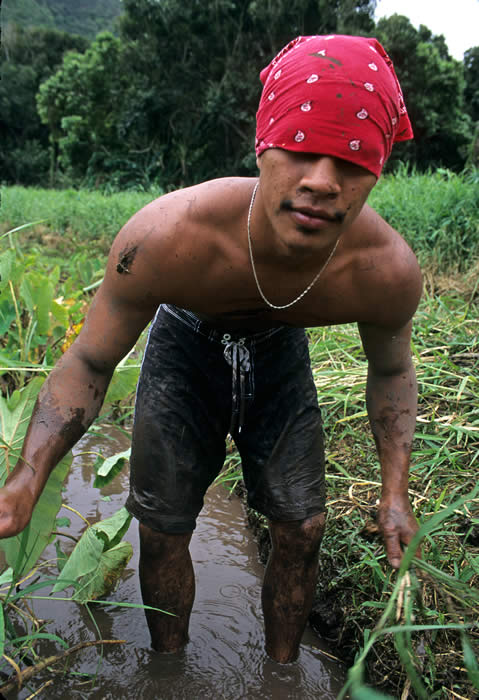
Cleaning irrigation ditch of ancient taro field
At Halawa, the men and women of Waipahu high School, all members of the
Hawaiian club there, would weed and clean two entire taro patches, working
way past their lunch break to get the job done.
"Tell them to stop," Kathy Davis, Glen's wife, told one of their teachers,
"they are trying to do too much."
"I think that would be useless," was the reply, "they really want to finish
the job."
That was on Thursday. Today, Friday, the 'kids' were equally tenacious
in wanting to complete the task of filling the walls of the fish pond
before lunch, but at one PM their teachers called a halt.
As the students gathered in the shade of a traditional hale to eat, I
sat on the shore penning the first few paragraphs of this article. I had
been alone for only a few minutes when one of the students brought me
lunch - they always serve the kupunas before eating themselves - and,
a few moments later, I was joined by Tua Tafaloa Ka'imihaku Mahe and his
friend Sheldon Keawe Kahaleua.
"May we sit with you?" Tua asked politely. "I don 't like to see someone
sitting alone. I feel sad that they might be lonely."
Putting down my pen and notebook I tore into my tuna fish sandwich while
enjoying the company of my new friends. We launched immediately into a
discussion of the last two days of their visit on Molokai with Tua, the
most loquacious of the pair, leading the way.
"It 's a blessing for me because our ancestors made those lo'i. It's touching.
It 's hard to explain."
"Yeah," Sheldon chimed in, "and we are also learning how to be helpful
in the future by bringing back the lo'i."
"The lo'i and the fish ponds," Tua continued, "are ways of producing food
instead of just taking food. In the lo'i we weed and harvest and replant
so they always give food and the same with the fishponds - to give back
instead of just taking. It has a lot to do with the environment, taking
care of it."
"We are the new Hawaiian generation," Sheldon said, completing Tua's thought.
Did Hokule'a play a part in creating the new Hawaiian generation, I wanted
to know.
"Hokule'a and Makali'i were big steps for Hawaii," Tua told me. "I got
to go aboard Makali'i. It was awesome. I am determined to ride on one
of those canoes in the future."
The three of us chatted for some time while waiting for work to resume.
As we were gathering up our paper plates and cups to head out to the beach
once more, Tua turned to me and said, "I love being in this club. It 's
the best thing. I love being Hawaiian. I feel like my ancestors are looking
at us, and they are smiling because they see one of their grandsons doing
this. I would be here every weekend if I could."
The work continued until the sun was making good progress toward the horizon
and the entire stretch of wall - 96 about 75 feet - had been filled with
stone.
"That 's a week's work for us," Scott said. "I love this project for many
reasons," he continued, "partly because when I pick up a rock I know I
am touching the same pohaku my kupunas touched a thousand years ago. I
also like it because the work is so open. You can see it from the road.
You cannot miss it. The young guys drive past and they stop and say, "hey
brah, what you doing? I like kokua.' It is the kind of project which makes
working hard cool again."
Pausing for a moment, and perhaps in response to an earlier question I
had asked him about the impact of Hokule'a on his own life, Scott said,
"we are doing something in plain sight that demonstrates what Hawaiians
can achieve. We had lost contact with our Hawaiian-ness and now we are
getting it back. In a way," he continued, "this project is our own personal
Hokule'a."
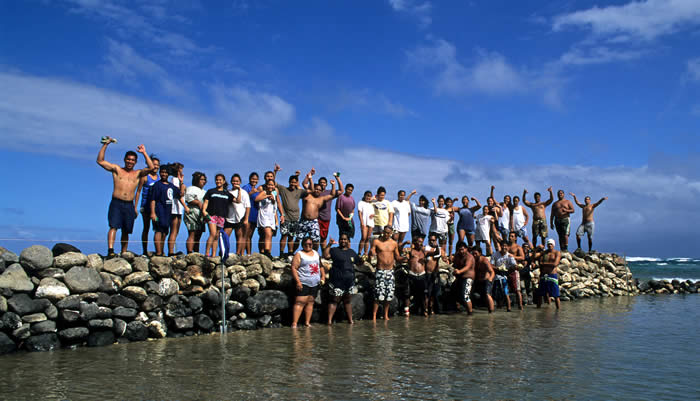
|

